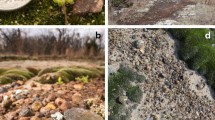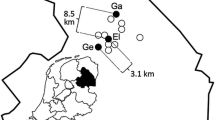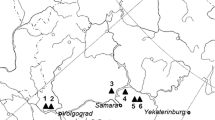Abstract
The loss of genetic diversity in fragmented populations ofself-incompatible plant species may result in sexual reproductive failure andlocal extinctions. Florida ziziphus (Ziziphus celata) is aself-incompatible clonal shrub known only from five genetically depauperatepopulations on the Lake Wales Ridge, Florida, USA. Recovery of this speciesrequires identification of cross-compatible genotypes that can be used to createviable (i.e., sexually reproducing) populations. To further development of arecovery program for this highly imperiled species, we investigated its geneticstructure and sexual reproductive viability. We used random amplifiedpolymorphic DNAs (RAPDs) to investigate genetic variability within remnantpopulations and we conducted experimental compatibility trials to determine thecross-compatibility of remnant genotypes. One hundred and ninety-nine uniquestem samples collected from one ex situ and fivein situ populations were assayed for the presence orabsence of a band for 32 RAPD markers. Based on unweighted pair-group meancluster analysis (UPGMA), only 11 multi-locus genotypes (MLGs) were identified.Eight of these MLGs correspond to MLGs identified in an earlier allozyme study.In addition, we identified three new RAPD-based MLGs. Three of the five naturalpopulations consisted of only one MLG, while the largest and most geneticallydiverse population comprised only four MLGs. Coefficients of similarity rangedfrom 96.6% for the most closely related MLGs to 20.7% for the most distantlyrelated. The compatibility trials demonstrated that most MLGs arecross-incompatible. With 69% of all possible one-way crosses tested (38/55), wehave identified only eight compatible crosses via germination trials. Based onthe results of the compatibility trials, we assigned MLGs toself-incompatibility (SI) mating types. On present evidence, the currentbreeding population of Florida ziziphus may comprise as few as two SI matingtypes. These SI mating types will be used to guide future breeding efforts andan experimental introduction.
Similar content being viewed by others
References
Aagaard J.E., Krutovskii K.V. and Strauss S.H. 1998. RAPDs and allozymes exhibit similar levels of diversity and differentiation among populations and races of Douglas-fir. Heredity 81: 69–78.
Ausubel F.M., Brent R., Kingston R.E., Moore D.D., Seidman J.G., Smith J.A. et al. 1987. Current Protocols in Molecular Biology. Wiley, New York
Ayers D.R. and Ryan F.J. 1997. The clonal and population structure of a rare endemic plant, Wyethia reticulata (Asteraceae): allozyme and RAPD analysis. Molecular Ecology 6: 761–772.
Ayers D.R. and Ryan F.J. 1999. Genetic diversity and structure of the narrow endemicWyethia reticulata and its congener W.bolanderi (Asteraceae) using RAPD and allozyme techniques. American Journal of Botany 86: 344–353.
Barrett S.C.H. and Kohn J.R. 1991. Genetic and evolutionary consequences of small population size in plants: implications for conservation. In: Falk D.A. and Holsinger K.E. (eds), Genetics and Conservation of Rare Plants. Oxford University Press, New York, pp. 3–30.
Brauner S., Crawford D.J. and Stuessy T.F. 1992. Ribosomal DNA and RAPD variation in the rare plant family Lactoridaceae. American Journal of Botany 79: 1436–1439.
Brown A.H.D. 1992. Human impact on plant gene pools and sampling for their conservation. Oikos 63: 109–118.
Charlesworth D. and Charlesworth B. 1987. Inbreeding depression and its evolutionary consequences. Annual Review of Ecology and Systematics 18: 237–268.
Christman S.P. and Judd W.S. 1990. Notes on plants endemic to Florida scrub. Florida Scientist 53: 52–73.
Coile N.C. 2000. Notes on Florida's Endangered and Threatened Plants. Florida Department of Agriculture and Consumer Services, Division of Plant Industry, Gainesville, Florida.
DeLaney K.R., Wunderlin R.P. and Hansen B.E. 1989. Rediscovery of Ziziphus celata (Rhamnaceae). Sida Contributions to Botany 13: 325–330.
DeMauro M.M. 1993. Relationship of breeding system to rarity in the Lakeside Daisy (Hymenoxys acaulis var. glabra). Conservation Biology 7: 542–550.
DeMauro M.M. 1994. Development and implementation of a recovery program for the federally threatened Lakeside daisy (Hymenoxys acaulis var. glabra). In: Bowles M.L. and Whelan C.J. (eds), Restoration of Endangered Species. Cambridge University Press, Cambridge, UK, pp. 298–321.
Eriksson O. and Bremer B. 1993. Genet dynamics of the clonal plant Rubus saxatilis. Journal of Ecology 81: 533–542.
Falk D.A., Millar C.I. and Olwell M. 1996. Restoring Diversity: Strategies for Reintroduction of Endangered Plants. Island Press, Washington, DC.
Frankel O.H., Brown A.H.D. and Burdon J.J. 1995. The Conservation of Plant Biodiversity. Cambridge University Press, Cambridge, UK.
Godt M.J.W., Hamrick J.L. and Bratton S. 1995. Genetic diversity on a threatened wetland species, Helonias bullata (Liliaceae). Conservation Biology 9: 596–604.
Godt M.J.W., Race T. and Hamrick J.L. 1997. A population genetic analysis of Ziziphus celata, an endangered Florida shrub. Journal of Heredity 88: 531–533.
Gordon D.R. 1994. Translocation of species into conservation areas: a key for natural resource managers. Natural Areas Journal 14: 31–37.
Gordon D.R. and Kubisiak T.L. 1998. RAPD analysis of the last population of a likely Florida Keys endemic cactus. Florida Scientist 61: 203–210.
Guerrant E.O. Jr 1996. Designing populations: demographic, genetic, and horticultural dimensions. In: Falk D.A., Millar C.I. and Olwell M. (eds), Restoring Diversity: Strategies for Reintroduction of Endangered Plants. Island Press, Washington, DC, pp. 171–207.
Hamrick J.L. and Godt M.J.W. 1990. Allozyme diversity in plant species. In: Brown A.H.D., Clegg M.G., Kohler A.L. and Weir B.S. (eds), Plant Population Genetics, Breeding and Genetic Resources. Sinauer Associates, Inc., Sunderland, Massachusetts, pp. 43–63.
Harrison S. and Bruna E. 1999. Habitat fragmentation and large-scale conservation: what do we know for sure? Ecography 22: 225–232.
Hartl D.L. 1988. A Primer of Population Genetics. Sinauer Associates, Inc., Sunderland, Massachusetts.
Huenneke L.F. 1991. Ecological implications of genetic variation. In: Falk D.A. and Holsinger K.E. (eds), Genetics and Conservation of Rare Plants. Oxford University Press, New York, pp. 31–44.
Isabel N., Beaulieu J. and Bousquet J. 1995. Complete congruence between gene diversity estimates derived from genotypic data at enzyme and random amplified polymorphic DNA loci in black spruce. Proceedings of the National Academy of Science USA 92: 6369–6373.
Jones B. and Gliddon C. 1999. Reproductive biology and genetic structure in Lloydia serotina. Plant Ecology 141: 151–161.
Judd W.S. and Hall D.W. 1984. A new species of Ziziphus (Rhamnaceae) from Florida. Rhodora 86: 381–387.
Knapp E.E. and Dyer A.R. 1998.When do genetic considerations require special approaches to ecological restoration? In: Fiedler P.L. and Kareiva P.M. (eds), Conservation Biology for the Coming Decade. Chapman & Hall, New York.
Kwak M.M., Velterop O. and van Andel J. 1998. Pollen and gene flow in fragmented habitats. Applied Vegetation Science 1: 37–54.
Lande R. 1998. Anthropogenic, ecological and genetic factors in extinction and conservation. Researches on Population Ecology 40: 259–269.
Les D.H., Reinartz J.A. and Esselman E.J. 1991. Genetic consequences of rarity in Aster furcatus (Asteraceae), a threatened, self-incompatible plant. Evolution 45: 1641–1650.
Luijten S.H. 2001. Reproduction and genetics of fragmented plant populations, Ph.D. Thesis, University of Amsterdam, Amsterdam.
McDonald D.B. and Hamrick J.L. 1996. Genetic variation in some plants of Florida scrub. American Journal of Botany 83: 21–27.
Menges E.S. 1999. Florida scrub. In: Anderson R.C., Fralish J.S. and Baskin J.M. (eds), The Savanna, Barren, and Rock Outcrop Plant Communities of North America. Cambridge University Press, Cambridge, UK, pp. 7–22.
Menges E.S., Dolan R.W., Yahr R. and Gordon D.R. 2001. Comparative genetics of seven plants endemic to Florida's Lake Wales Ridge. Castanea 66: 98–114.
Myers R.L. 1990. Scrub and high pine. In: Myers R.L. and Ewel J.J. (eds), Ecosystems of Florida. University of Central Florida Press, Orlando, Florida, pp. 150–193.
Nei M. 1973. Analysis of gene diversity in subdivided populations. Proceedings of the National Academy of Science USA 70: 3321–3323.
Nei M. 1975. Molecular Population Genetics and Evolution. Elsevier, New York.
Noss R.F. and Cooperrider A.Y. 1994. Saving Nature's Legacy: Protecting and Restoring Biodiversity. Island Press, Washington, DC.
Palacios C. and Gonzalez-Candelas F. 1997. Analysis of population genetic structure and variability using RAPD markers in the endemic and endangered Limonium dufourii (Plumbaginaceae). Molecular Ecology 6: 1107–1121.
Pavlik B.M., Nickrent D.L. and Howald A.M. 1993. Creating a new population of Amsinckia grandiflora. Conservation Biology 7: 510–526.
Pavlik B.M. 1996. Defining and measuring success. In: Falk D.A., Millar C.I. and Olwell M. (eds), Restoring Diversity: Strategies for Reintroduction of Endangered Plants. Island Press, Washington, DC, pp. 127–155.
Perez H.E. 2001. Germination of six Florida native endangered species, M.A. Thesis, University of Florida, Gainesville, Florida.
Peroni P.A. and Abrahamson W.G. 1986. A rapid method of determining losses of native vegetation. Natural Areas Journal 5: 20–24.
Richards A.J. 1986. Plant Breeding Systems. Allen and Unwin, London.
Rohlf F.J. 1994. NTSYS-pc Numerical Taxonomy and Multivariate Analysis System, version 1.80. Exeter Software, Setauket, New York.
Saunders D., Hobbs R.J. and Margules C.R. 1991. Biological consequences of ecosystem fragmentation: a review. Conservation Biology 5: 18–32.
Soil Conservation Service 1989. Soil survey of Highlands County, Florida. United States Department of Agriculture, Gainesville, Florida.
Soil Conservation Service 1990. Soil survey of Polk County, Florida. United States Department of Agriculture, Gainesville, Florida.
Steinger T., Korner C. and Schmid B. 1996. Long-term persistence in a changing climate: DNA analysis suggests very old ages of clones of alpine Carex curvula. Oecologia 105: 94–99.
Stephenson A.G. 1981. Flower and fruit abortion: proximate causes and ultimate functions. Annual Review of Ecology and Systematics 12: 253–279.
US Fish and Wildlife Service 1999. Florida Ziziphus. In: Multi-Species Recovery Plan for the Threatened and Endangered Species of South Florida. US Fish and Wildlife Service, Atlanta, Georgia, pp. 1986–1989.
Van Buren R., Harper K.T., AndersenW.R., Stanton D.J., Seyoum S. and England J.L. 1994. Evaluating the relationship of autumn buttercup (Ranunculus acriformis var. aestivalis) to some close congeners using random amplified polymorphic DNA. American Journal of Botany 81: 514–519.
Wagner D.B., Furnier G.R., Saghai-Maroof M.A., Williams S.M., Dancik B.P. and Allard R.W. 1987. Chloroplast DNA polymorphisms in lodgepole and jack pines and their hybrids. Proceedings of the National Academy of Science USA 84: 2097–2100.
Warburton C.L., James E.A., Fripp Y.J., Trueman S.J. and Wallace H.M. 2000. Clonality and sexual reproductive failure in remnant populations of Santalum lanceolatum (Santalaceae). Biological Conservation 96: 45–54.
Weekley C.W. and Race T.M. 1999. 10-Year status report on Ziziphus celata, a federally listed endemic plant of the Lake Wales Ridge, Florida. US Fish and Wildlife Service, Vero Beach, Florida.
Weekley C.W. and Race T. 2001. The breeding system of Ziziphus celata Judd and D. Hall (Rhamnaceae), a rare endemic plant of the Lake Wales Ridge, Florida. Biological Conservation 100: 207–213.
Weller S.G. 1994. The relationship of rarity to plant reproductive biology. In: Bowles M.L. and Whelan C.J. (eds), Restoration of Endangered Species. Cambridge University Press, Cambridge, UK, pp. 90–117.
Wilcove D.S., McLellan C.H. and Dobson A.P. 1986. Habitat fragmentation in the temperate zone. In: Soule M.E. (ed.), Conservation Biology: The Science of Scarcity and Diversity. Sinauer Associates, Inc., Sunderland, Massachusetts, pp. 237–256.
Williams J.G.K., Kubelik A.R., Livak K.J., Rafalski J.A. and Tingey S.V. 1990. DNA polymorphisms amplified by arbitrary primers are useful as genetic markers. Nucleic Acids Research 18: 6531–6535.
Wong K.C. and Sun M. 1999. Reproductive biology and conservation genetics of Goodyera procera (Orchidaceae). American Journal of Botany 86: 1406–1413.
Wunderlin R.P. 1998. Guide to the Vascular Plants of Florida. University Press of Florida, Gainesville, Florida.
Young A., Boyle T. and Brown T. 1996. The population genetic consequences of habitat fragmentation for plants. TREE 11: 413–418.
Young A.G., Brown A.H.D. and Zich F.A. 1999. Genetic structure of fragmentated populations of the endangered daisy Rutidosis leptorrhynchoides. Conservation Biology 13: 256–265.
ZomleferW.B. 1989. Flowering Plants of Florida: A Guide to Common Families. Biological Illustrations, Inc., Gainesville, Florida.
Author information
Authors and Affiliations
Rights and permissions
About this article
Cite this article
Weekley, C., Kubisiak, T. & Race, T. Genetic impoverishment and cross-incompatibility in remnant genotypes of Ziziphus celata (Rhamnaceae), a rare shrub endemic to the Lake Wales Ridge, Florida. Biodiversity and Conservation 11, 2027–2046 (2002). https://doi.org/10.1023/A:1020810800820
Issue Date:
DOI: https://doi.org/10.1023/A:1020810800820




